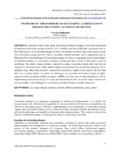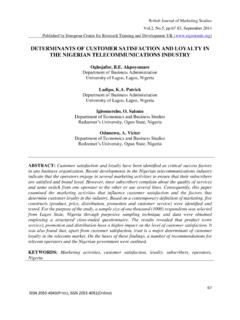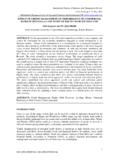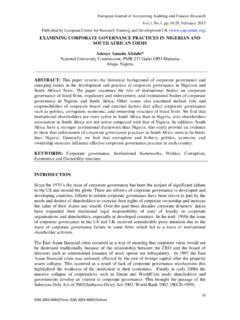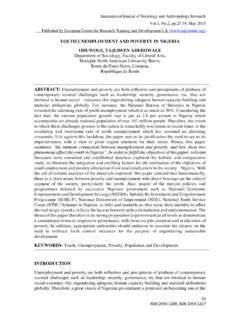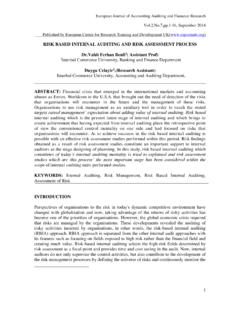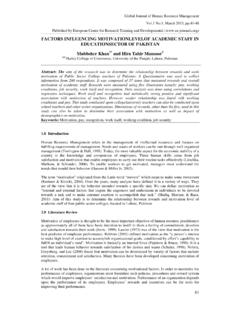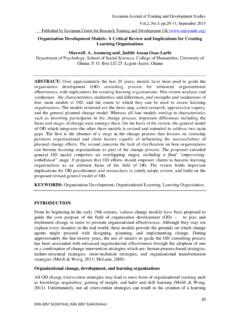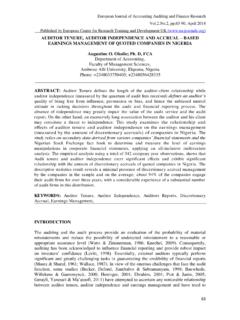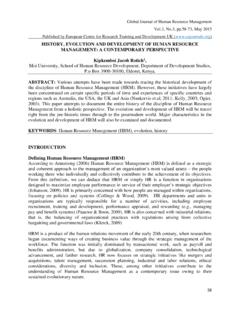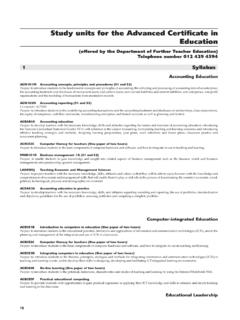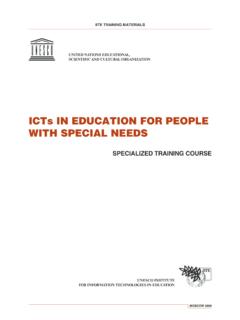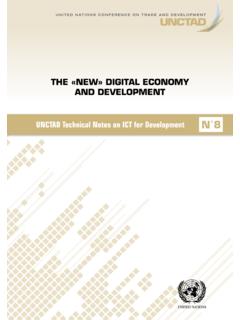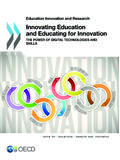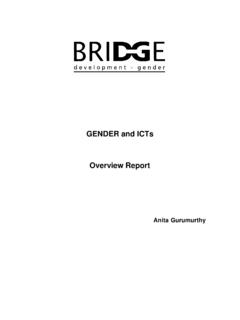Transcription of European Journal of Computer Science and …
1 European Journal of Computer Science and Information Technology (EJCSIT) , , , September 2013 Published by European Centre for Research Training and Development UK ( ) 10 THE USE AND MANAGEMENT OF ICT IN SCHOOLS: STRATEGIES FOR SCHOOL LEADERS Adu, , Dean: Faculty of Education BA ISAGO University College Gaborone. Botswana +267 71779202 Olatundun, , Oyo State Secretariat. Ibadan Nigeria +2348032366471 ABSTRACT: Information and communication technologies (ICT) have become commonplace entities in all aspects of life. Across the past twenty years the use of ICT has fundamentally changed the practices and procedures of nearly all forms of endeavour within business and governance. Education is a very socially oriented activity and quality education has traditionally been associated with strong teachers having high degrees of personal contact with learners.
2 Many important changes have occurred in the last few years in the education systems, which will require teachers and school leaders to upgrade and refine their technology skills. Some of these changes are due to changes in government policies related to the use of information communication and technology (ICT) in schools while others are due to developments in state of the art p edagogical practices .As technology flows faster into the sch ools, many school leaders are facing a range of difficult management issues. This article discusses the potential use of ICT in schools and also issues related to ICT integration. In managing the use of ICT in schools some strategies are suggested and discussed for the school leaders to adhere to. KEYWORDS: ICT, School, Strategies, Leaders INTRODUCTION According to Daniels (2002) ICTs have become within a very short time, one of the basic building blocks of modern society.
3 Many countries now regard understanding ICT and mastering the basic skills and concepts of ICT as part of the core of education, alongside reading, writing and numeracy. However, there appears to be a misconception that ICTs generally refers to computers and computing related activities . This is fortunately not the case, although computers and their application play a significant role in modern information management, other technologies and/or systems also comprise of the phenomenon that is commonly regarded as ICTs. Pelgrum and Law (2003) state that near the end of the 1980s, the term computers was replaced by IT (information technology) signifying a shift of focus from computing technology to the capacity to store and retrieve information. This was followed by the introduction of the European Journal of Computer Science and Information Technology (EJCSIT) , , , September 2013 Published by European Centre for Research Training and Development UK ( ) 11 term ICT (information and communication technology) around 1992, when e-mail started to become available to the general public (Pelgrum, , Law, N.)
4 , 2003). According to a United Nations report (1999) ICTs cover Internet service provision, telecommunications equipment and services, information technology equipment and services, media and broadcasting, libraries and documentation centers, commercial information providers, network-based information services, and other related information and communication activities. The field of education has been affected by ICTs, which have undoubtedly affected teaching, learning, and research (Yusuf, 2005). A great deal of research has proven the benefits to the quality of education (Al-Ansari, 2006). ICTs have the potential to innovate, accelerate, enrich, and deepen skills, to motivate and engage students, to help relate school experience to work practices, create economic viability for tomorrow's workers, as well as strengthening teaching and helping schools change (Davis and Tearle, 1999; Lemke and Coughlin, 1998; cited by Yusuf, 2005).
5 As Jhurree (2005) states, much has been said and reported about the impact of technology, especially computers, in education. During the past decade there has been an exponential growth in the use of information commun ication an d technolo gy (ICT) which has pervasive impacts both on society and on our daily lives. It is thus not surprising to find increasing interest, attention and investment being put into the use of ICT in education all over the world. In addition to t h e e f f o r t s t o e m p l o y I C T t o i m p r o v e l e a r n i n g , t h e e m e r g e n c e o f t h e k n o w le d g e economy has also brought about much greater emphasis on education. In responding to th e imp act of ICT i n edu cation th ere are some fu ndamental areas wh ere ICT pla ys crucial roles.
6 Th ese include: ICT ENHANCING THE QUALITY AND ACCESSIBILITY OF EDUCATION ICT increases the flexibility of delivery of education so that learners can access knowledge anytime and from anywhere. It can influence the way students are taught and how they learn as now the processes are learner driven and not by teachers. This in turn would better prepare the learners for lifelong learning as well as to improve the quality of learning. In concert with geographical flexibility, technology-facilitated educational programs also remove many of the temporal constraints that face learners with special needs (Moore & Kearsley, 1996). Students are starting to appreciate the capability to undertake education anywhere, anytime and anyplace. One of the most vital contributions of ICT in the field of education is- Easy Access to Learning.
7 With the help of ICT, students can now browse through e-books, sample examination papers, previous year papers etc. and can also have an easy access to resource persons, mentors, experts, researchers, professionals, and peers-all over the world. This flexibility has heightened the availability of just-in-time learning and provided learning opportunities for many more learners who previously were constrained by other commitments (Young, 2002). Wider availability of best practices and best course material in education, which can be shared by means of ICT, can foster better teaching. ICT also allows the academic institutions to reach disadvantaged groups and new international educational markets. As well as learning at any time, teachers are also European Journal of Computer Science and Information Technology (EJCSIT) , , , September 2013 Published by European Centre for Research Training and Development UK ( ) 12 finding the capabilities of teaching at any time to be opportunistic and able to be used to advantage.
8 Mobile technologies and seamless communications technologies support 24x7 teaching and learning. Choosing how much time will be used within the 24x7 envelope and what periods of time are challenges that will face the educators of the future (Young, 2002). Thus, ICT enabled education will ultimately lead to the democratization of education. Especially in developing countries like India, effective use of ICT for the purpose of education has the potential to bridge the digital divide. India has a billion-plus population and a high proportion of the young and hence it has a large formal education system. The demand for education in developing countries like India has skyrocketed as education is still regarded as an important bridge of social, economic and political mobility (Amutabi and Oketch, 2003).
9 There exist infrastructure, socio- economic, linguistic and physical barriers in India for people who wish to access education Bhattacharya and Sharma, 2007). This includes infrastructure, teacher and the processes quality. There exist drawbacks in general education in India as well as all over the world like lack of learning materials, teachers, remoteness of education facilities, high dropout rate etc. (UNESCO,2002). Innovative use of Information and Communication Technology can potentially solve this problem. Internet usage in home and work place has grown exponentially (McGorry, 2002). ICT has the potential to remove the barriers that are causing the problems of low rate of education in any country. It can be used as a tool to overcome the issues of cost, less number of teachers, and poor quality of education as well as to overcome time and distance barriers (McGorry, 2002).
10 ICT ENHANCING LEARNING ENVIRONMENT ICT presents an entirely new learning environment for students, thus requiring a different skill set to be successful. Critical thinking, research, and evaluation skills are growing in importance as students have increasing volumes of information from a variety of sources to sort through (New Media Consortium, 2007).ICT is changing processes of teaching and learning by adding elements of vitality to learning environments including virtual environments for the purpose. ICT is a potentially powerful tool for offering educational opportunities. It is difficult and maybe even impossible to imagine future learning environments that are not supported, in one way or another, by Information and Communication Technologies (ICT). When looking at the current widespread diffusion and use of ICT in modern societies, especially by the young the so-called digital generation then it should be clear that ICT will affect the complete learning process today and in the future.
